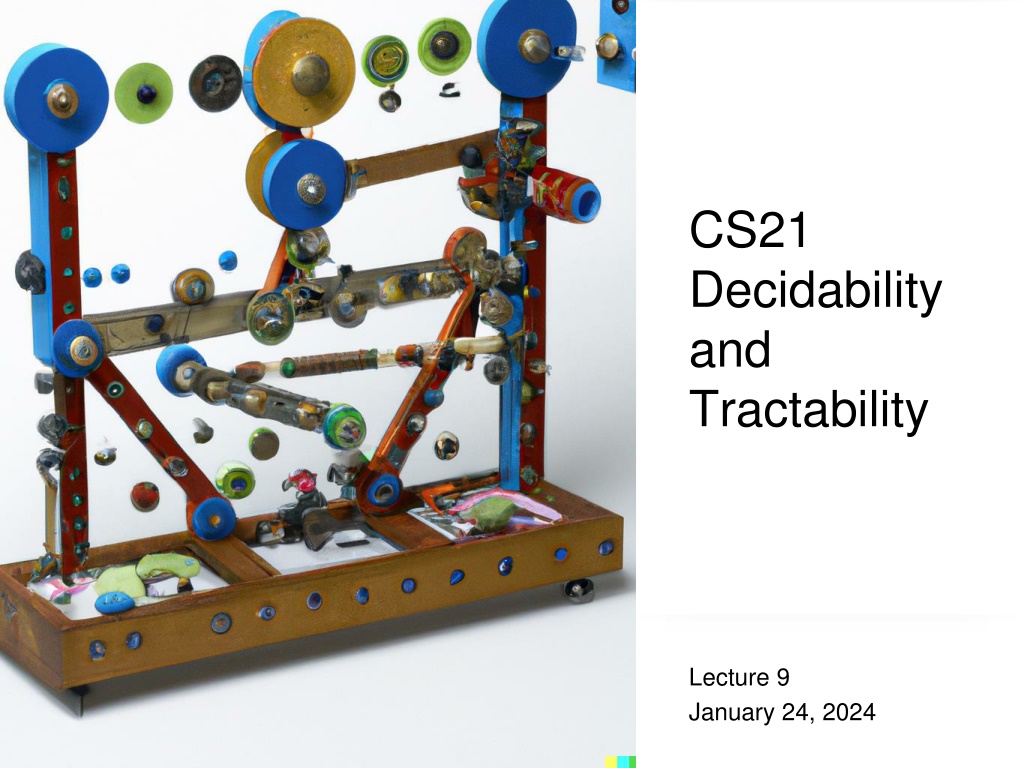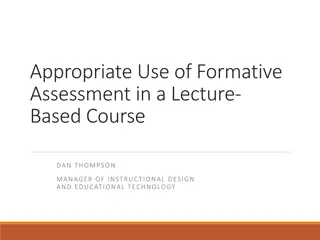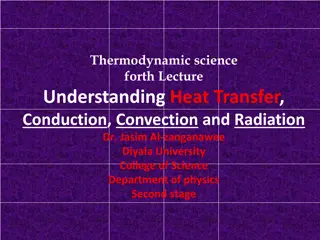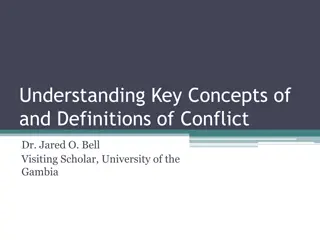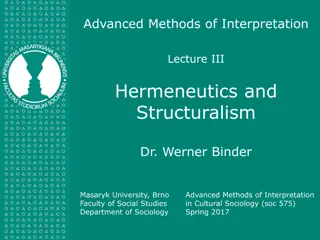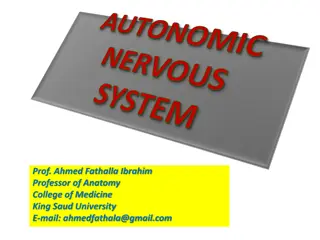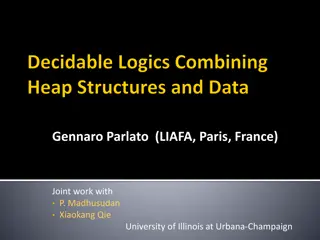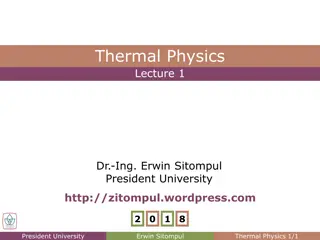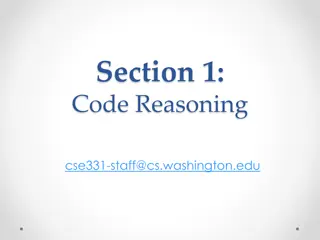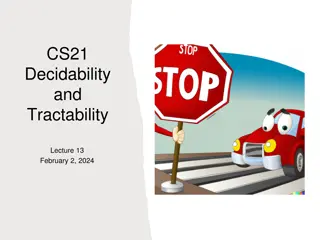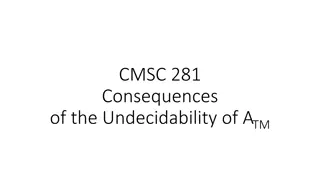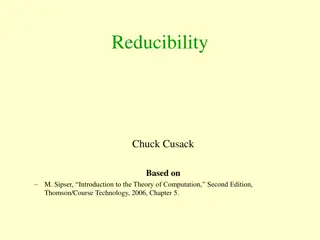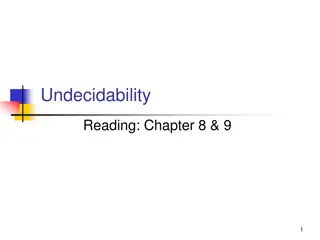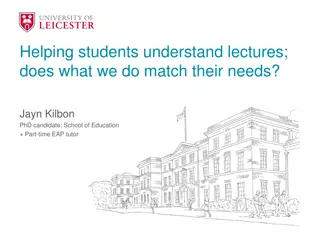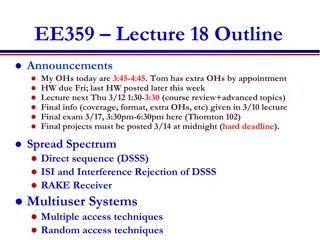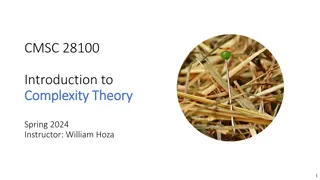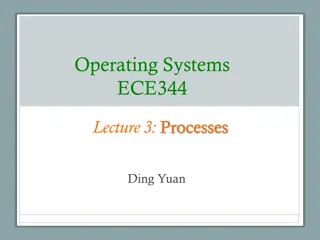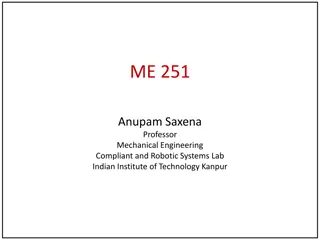Understanding Decidability and Tractability in CS21 Lecture
Explore the concepts of decidability and tractability in the CS21 lecture on January 24, 2024. The lecture covers topics such as converting context-free grammars into Chomsky Normal Form, algorithms for determining language generation, worst-case running times, dynamic programming strategies, and deterministic PDAs.
Download Presentation

Please find below an Image/Link to download the presentation.
The content on the website is provided AS IS for your information and personal use only. It may not be sold, licensed, or shared on other websites without obtaining consent from the author. Download presentation by click this link. If you encounter any issues during the download, it is possible that the publisher has removed the file from their server.
E N D
Presentation Transcript
CS21 Decidability and Tractability Lecture 9 January 24, 2024
Deciding CFLs Convert CFG into Chomsky Normal Form parse tree for string x generated by nonterminal A: If A k x (k > 1) then there must be a way to split x: A B C x = yz A BC is a production and B i y and C j z for i, j < k x January 24, 2024 CS21 Lecture 9 2
Deciding CFLs An algorithm: IsGenerated(x, A) if |x| = 1, then return YES if A x is a production, else return NO for all n-1 ways of splitting x = yz for all m productions of form A BC if IsGenerated(y, B) and IsGenerated(z, C), return YES return NO worst case running time? January 24, 2024 CS21 Lecture 9 3
Deciding CFLs worst case running time exp(n) Idea: avoid recursive calls build table of YES/NO answers to calls to IsGenerated, in order of length of substring example of general algorithmic strategy called dynamic programming notation: x[i,j] = substring of x from i to j table: T(i, j) contains {A: A nonterminal such that A * x[i,j]} January 24, 2024 CS21 Lecture 9 4
Deciding CFLs IsGenerated(x = x1x2x3 xn, G) for i = 1 to n T[i, i] = {A: A xi is a production in G} for k = 1 to n - 1 for i = 1 to n - k for k splittings x[i, i+k] = x[i,i+j]x[i+j+1, i+k] T[i, i+k] = {A: A BC is a production in G and B T[i,i+j] and C T[i+j+1,i+k] } output YES if S T[1, n], else output NO January 24, 2024 CS21 Lecture 9 5
Deciding CFLs IsGenerated(x = x1x2x3 xn, G) for i = 1 to n T[i, i] = {A: A xi is a production in G} for k = 1 to n - 1 for i = 1 to n - k for k splittings x[i, i+k] = x[i,i+j]x[i+j+1, i+k] T[i, i+k] = {A: A BC is a production in G and B T[i,i+j] and C T[i+j+1,i+k] } output YES if S T[1, n], else output NO O(nm) steps O(n3m3) steps January 24, 2024 CS21 Lecture 9 6
Deterministic PDA A NPDA is a 6-tuple (Q, , , , q0, F) where: :Q x ( { }) x ( { }) P (Q x ( { })) is a function called the transition function A deterministic PDA has only one option at every step: for every state q Q, a , and t , exactly 1 element in (q, a, t), or exactly 1 element in (q, , t), and (q, a, t) empty for all a January 24, 2024 CS21 Lecture 9 7
Deterministic PDA A technical detail: we will give our deterministic machine the ability to detect end of input string add special symbol to alphabet require input tape to contain x language recognized by a deterministic PDA is called a deterministic CFL (DCFL) January 24, 2024 CS21 Lecture 9 8
Example deterministic PDA 0, 0 , $ = {0, 1} 1, 0 = {0, 1, $} , $ 1, 0 L = {0n1n : n 0} (unpictured transitions go to a reject state and stay there) January 24, 2024 CS21 Lecture 9 9
Deterministic PDA Theorem: DCFLs are closed under complement (complement of L in * is ( * - L) ) Proof attempt: swap accept/non-accept states problem: might enter infinite loop before reading entire string machine for complement must accept in these cases, and read to end of string January 24, 2024 CS21 Lecture 9 10
Example of problem 1, 0, 0, , , 1, , $ , $ Language of this DPDA is 0 * January 24, 2024 CS21 Lecture 9 11
Example of problem 1, 0, 0, , , 1, , $ , $ Language of this DPDA is {?} January 24, 2024 CS21 Lecture 9 12
Deterministic PDA Proof: convert machine into normal form always reads to end of input always enters either an accept state or single distinguished reject state, and stay there step 1: keep track of when we have read to end of input step 2: eliminate infinite loops January 24, 2024 CS21 Lecture 9 13
Deterministic PDA step 1: keep track of when we have read to end of input q0 q0 q1 q1 , ? ? , ? ? q3 q3 q2 q2 January 24, 2024 CS21 Lecture 9 14
Deterministic PDA step 1: keep track of when we have read to end of input , ? ? q0 q0 q1 q1 , ? ? q3 q3 q2 q2 for accept state q : replace outgoing , ? ? transition with self-loop with same label January 24, 2024 CS21 Lecture 9 15
Deterministic PDA step 2: eliminate infinite loops add new reject states a, t t (for all a, t) , t t (for all t) r r , t t (for all t) January 24, 2024 CS21 Lecture 9 16
Deterministic PDA step 2: eliminate infinite loops on input x, if infinite loop, then: stack height time i0 i1i2 i3 infinite sequence i0< i1< i2< such that for all k, stack height never decreases below ht(ik) after time ik January 24, 2024 CS21 Lecture 9 17
Deterministic PDA step 2: eliminate infinite loops infinite seq. i0< i1< such that for all k, stack height never decreases below ht(ik) after time ik infinite subsequence j0< j1< j2< such that same transition is applied at each time jk never see any stack symbol below t from jk on we are in a periodic, deterministic sequence of stack operations independent of the input p , t s January 24, 2024 CS21 Lecture 9 18
Deterministic PDA step 2: eliminate infinite loops infinite subsequence j0< j1< j2< such that same transition is applied at each time jk safe to replace: a, t t (for all a, t) , t t (for all t) , t s r p r , t s , t s , t t (for all t) or p , t s CS21 Lecture 9 19
Deterministic PDA finishing up have a machine M with no infinite loops therefore it always reads to end of input either enters an accept state q , or enters reject state r now, can swap: make r unique accept state to get a machine recognizing complement of L January 24, 2024 CS21 Lecture 9 20
Summary Nondeterministic Pushdown Automata (NPDA) Context-Free Grammars (CFGs) describe Context-Free Languages (CFLs) terminals, non-terminals productions yields, derivations parse trees January 24, 2024 CS21 Lecture 9 21
Summary grouping determined by grammar Chomsky Normal Form (CNF) NDPAs and CFGs are equivalent CFL Pumping Lemma is used to show certain languages are not CFLs January 24, 2024 CS21 Lecture 9 22
Summary deterministic PDAs recognize DCFLs DCFLs are closed under complement there is an efficient algorithm (based on dynamic programming) to determine if a string x is generated by a given grammar G January 24, 2024 CS21 Lecture 9 23
So far several models of computation finite automata pushdown automata fail to capture our intuitive notion of what is computable all languages regular languages context free languages January 24, 2024 CS21 Lecture 9 24
So far We proved (using constructions of FA and NPDAs and the two pumping lemmas): {anbn : n 0 } {w : w {a,b}* has an even # of b s} regular languages all languages context free languages {anbncn : n 0 } January 24, 2024 CS21 Lecture 9 25
A more powerful machine limitation of NPDA related to fact that their memory is stack-based (last in, first out) What is the simplest alteration that adds general-purpose memory to our machine? Should be able to recognize, e.g., {anbncn : n 0 } January 24, 2024 CS21 Lecture 9 26
Turing Machines input tape 0 1 1 0 0 1 1 1 0 1 0 0 finite control read/write head q0 New capabilities: infinite tape can read OR write to tape read/write head can move left and right January 24, 2024 CS21 Lecture 9 27
Turing Machine Informal description: input written on left-most squares of tape rest of squares are blank at each point, take a step determined by current symbol being read current state of finite control a step consists of writing new symbol moving read/write head left or right changing state January 24, 2024 CS21 Lecture 9 28
Example Turing Machine language L = {w#w : w {0,1}*} input tape 0 1 # 0 1 finite control q0 read/write head January 24, 2024 CS21 Lecture 9 29
Turing Machine diagrams a b,L a R states (1 accept + 1 reject) start state b L b R qreject qaccept b a,R transition label: (tape symbol read tape symbol written, direction moved) _ means blank tape square a R means read a, move right a L means read a, move left a b, R means read a, write b, move right January 24, 2024 CS21 Lecture 9 30
Example TM diagram 0,1 R 0,1 R 0,1,# L 0,1 R x R # R _ L _ R # R q1 q3 q5 q7 q9 0 _,R 0 x, R 0 x, L x R # R x R _ R 0,1,x,# L _ R q0 q11 q12 q13 qaccept # R 1 x, R 1 x, L 1 _,R q2 q4 q6 q8 q10 # R _ L _ R # R 0,1 R 0,1 R 0,1,# L 0,1 R x R January 24, 2024 CS21 Lecture 9 31
